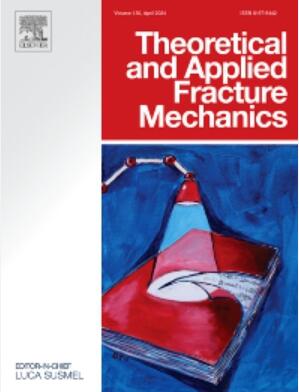Analysis of the fracture response of anchored rock under three-point bending from experimental and numerical perspectives
IF 5
2区 工程技术
Q1 ENGINEERING, MECHANICAL
引用次数: 0
Abstract
The stability and bearing capacity of fractured surrounding rock in underground engineering are affected by the support conditions. In this study, an anchored rock unit was selected as an object for fracture mechanics three-point bending tests by varying the anchorage position. The results showed that the fracture toughness (KIC) of the anchored specimens showed a decreasing trend with the increase in the distance of the bolt center from the crack tip (Da), while exhibiting an increase of 21.18 ∼ 135.32 % in comparison to the unanchored specimens. The change in axial force of the bolt with time can be classified into three stages: initial change, significant elevation, and liner increase. Besides, the sensitivity of the anchored specimens to the crack opening distance was significantly reduced and the ultimate tensile strains were commonly larger than the unanchored. Meanwhile, a numerical model consistent with the properties of the medium was developed using the PFC-FLAC coupling method. The simulation results show that the anchorage position and preload influence the mechanical parameters such as KIC and the bolt-enhanced fracture energy (Gb), while improving the stress concentration phenomenon at the crack tip.
从实验和数值角度分析三点弯曲下锚固岩石的断裂响应
在地下工程中,断裂围岩的稳定性和承载力受到支护条件的影响。本研究选择了一个锚固岩石单元作为对象,通过改变锚固位置进行断裂力学三点弯曲试验。结果表明,锚固试样的断裂韧性(KIC)随螺栓中心距裂缝顶端的距离(Da)增加而呈下降趋势,但与未锚固试样相比,KIC 增加了 21.18 ∼ 135.32 %。螺栓轴向力随时间的变化可分为三个阶段:初始变化、显著升高和衬垫增加。此外,锚固试样对裂缝张开距离的敏感性明显降低,极限拉伸应变普遍大于非锚固试样。同时,利用 PFC-FLAC 耦合方法建立了与介质特性相一致的数值模型。模拟结果表明,锚固位置和预紧力会影响 KIC 和螺栓增强断裂能(Gb)等力学参数,同时改善裂纹尖端的应力集中现象。
本文章由计算机程序翻译,如有差异,请以英文原文为准。
求助全文
约1分钟内获得全文
求助全文
来源期刊

Theoretical and Applied Fracture Mechanics
工程技术-工程:机械
CiteScore
8.40
自引率
18.90%
发文量
435
审稿时长
37 days
期刊介绍:
Theoretical and Applied Fracture Mechanics'' aims & scopes have been re-designed to cover both the theoretical, applied, and numerical aspects associated with those cracking related phenomena taking place, at a micro-, meso-, and macroscopic level, in materials/components/structures of any kind.
The journal aims to cover the cracking/mechanical behaviour of materials/components/structures in those situations involving both time-independent and time-dependent system of external forces/moments (such as, for instance, quasi-static, impulsive, impact, blasting, creep, contact, and fatigue loading). Since, under the above circumstances, the mechanical behaviour of cracked materials/components/structures is also affected by the environmental conditions, the journal would consider also those theoretical/experimental research works investigating the effect of external variables such as, for instance, the effect of corrosive environments as well as of high/low-temperature.
 求助内容:
求助内容: 应助结果提醒方式:
应助结果提醒方式:


